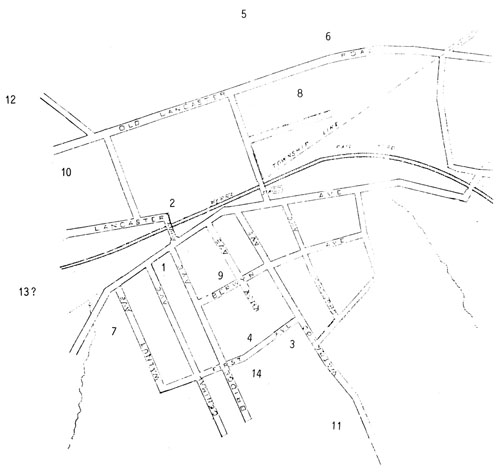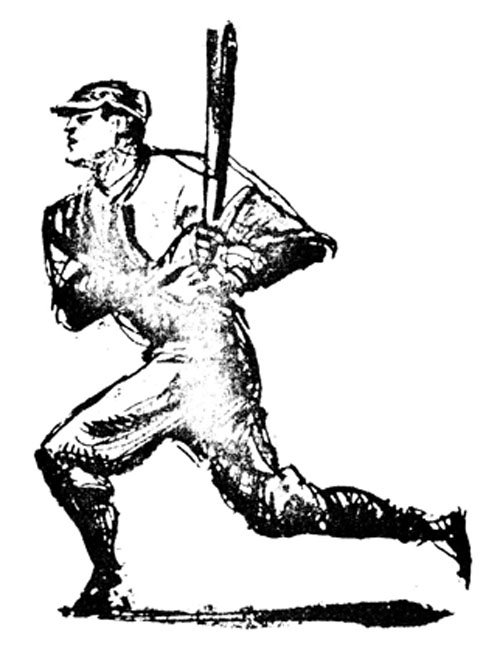|
Home : Quarterly Archives : Volume 27 |
Tredyffrin Easttown Historical Society |
|
Source: April 1989 Volume 27 Number 2, Pages 53–57 Baseball Fields in Berwyn I believe that the first baseball club in this area was located at the Leopard, when John Hayman and Isaac A. Cleaver had a team there. A team was organized in Berwyn in about 1880. The nine included William Dawson (whom the locals insisted in calling "Bill Dawsey"), catcher; Harry Armstrong, pitcher; John Burns, 1st base; Frank Stauffer, 2nd base; Geo. Moran, 3rd base; Wash Lewis, shortstop; Pete Lawless, left field; Jimmie Anderson (a Scotch mason), center field; and Bob Williams in right field. Their only uniform was a blue cap. Some one dubbed them the "Johnny Jumpups", but they were far from proficient; in one game the Media team beat them, 42 to 2, and in another they lost to the West Chester Browns by a 47 to 9 score! Later Shorty Hayman and Andy Dellinger, two telegraph operators, became the battery, and the team had uniforms. They continued to play such teams as Delaware County Howelltown, Parkesburg, Ardmore, Media, and other well-known nines, but still with little success. Finally, W. H. Fritz secured a battery from the City, Perry and Coleman. Perry had a "roundhouse" curve ball; he was the first pitcher on the Berwyn team to deliver anything more than just a fast ball.
EARLY BASEBALL FIELDS IN BERWYN used at various times between 1880 and 1920 Jacob Seasholtz managed the mediocre nine for a short time before his death. Then his successor in the little drug store around the corner, William Harm, organized a winning team. It included John and Harry Seasholtz, John Jardine, Elwood Hayman, James Farra, Harry Garber, Wilbur Speakman, Edward Kelly, Harry Fritz, Colt Smith, and others, and was worthy to cope with the best of the local clubs. The Seasholtzes had played with the City Park Sparrows; Farra with the Delaware County Howelltown club, and Speakman with the West Chester Brandywine nine. The team thereafter had a large following and gained the respect of their rivals as being hard to beat. The first field laid out by the Berwyn team was on the west side of Bridge Avenue, just south of Rees Lewis' barn, the home plate later the site of the Grammar School [see #1 on the map]. This ground was soon disposed of, and the club moved to the southeast corner of the pike and Bridge Avenue, next to Fritz's field [#2], where the game with the West Chester Browns was played. There were no backstops on either of these fields. By the time the team had acquired its first curve-ball pitcher it was playing at Coates' field, at the southwest corner of Waterloo and First avenues [#3], but later they moved across the street to Washington Baker's lots in back of Zeb Lobb's house, slightly to the west and on the north side of First Avenue [#4]. When this ground was built up, they removed to the northeast corner of Peter Burns' farm, about a quarter of a mile north of the old Lancaster Road [now Conestoga Road] on the north side of Berwyn [#5]. Later they played on a part of the Kellar farm, where Comley Hall soon built his house [#6]. The next location was on the John Potter place, west of Walnut Avenue [#7] and then back to the Kellar farm, between the old Lancaster Road and Kromer Avenue [#8]. There, for the first time, they graded the field, put up a "grandstand", and had a superior amateur nine -- Farra, c; Noblett, p.; H. Seasholtz, 1st b.; H. Fritz, 2nd b.; Potter, 3rd b.; Speakman, s.s.; Elwood Hayman, l.f.; Mercer, c.f.; and E. Kelley, r.f. On a Fourth of July they defeated the famous Terra Cotta team of Philadelphia and its star pitcher Jordan, 1 to 0. City teams were glad to come out for their car fare. It was while on these grounds that Rapp, a one-eyed boy from West Chester, became Berwyn's star pitcher when he defeated Dickey's team from Ardmore, 7 to 2, even though Bob Dickey, a highly regarded pitcher, and Charles Humphrey, an ex-Princeton catcher, were playing for the opposition. The urge to play was unbelievably strong. Mechanics abandoned the most important jobs and others risked dismissal from their positions to play, or to witness the fortunes of the team. On one occasion the team had hired a bus to take them across the county to a game. They halted on the pike at "Brown's Row" and the players all shouted across to the railroad tower where their left fielder, Elwood Hayman, was stationed as operator, "Hey Shorty, hurry up!" Poor Shorty Hayman was in a quandary, as his superior, who had come out from the City to ascertain why his telegraph operator regularly returned a "sick report" every Saturday, was also in the tower at the time! The team could always secure a game any weekday afternoon at a moment's notice with the colored waiters at the Devon Inn -- the Aller and Perry brothers, Burnett, Roderick, Thomson, Jackson, and a Lybian student from Lincoln University -- who were accustomed to playing together and put up a skillful game. Some of their players at one time or another played for the Cuban or ex-Cuban Giants. Building operations, as usual, eventually caused the abandonment of this Kellar farm field too, and the Aiken lot on the northwest corner of Knox and Berwyn avenues [#9] became the stand for many years. Here practice every weekday evening until it was too dark to see a fly ball developed one of the greatest amateur batting teams in the country. The personnel varied as years passed, but a characteristic nine would be Cliff Gaunt, c; Walker or Ramsey, p.; Jesse Shank, 1st b.; Sam Dickey, 2nd b.; Potter or Lapp, 3rd b.; Campbell, s.s.; and, for fielders, Kirkoff, Walker, Paist, or Ramsey. It was during this time that the Main Line League was formed, of which Byler of the West Philadelphia nine and Harry Seasholtz of the Berwyn club were the principal originators. On the occasion of a big game with Morristown, West Chester, and other broroughs the club sometimes made use of professional players -- Whiting, a pitcher, Jacklitz, a catcher, Murphy, at first base. I remember that in one game with Malvern, Berwyn was without the services of its first baseman, Shank having gone over to the rival club, who had imported a veteran professional battery. A fellow named King, a former member of the York team in the Tri-State League, applied for the job. Although he showed up badly in practice, dropping nearly every thrown ball, in the actual contest he pulled off a lightning double play. Berwyn was far in the lead when the game ended in a row after the umpire reversed his decision. With Barney Slaughter and "Help me, Lord" Lehman (a remarkable catcher afflicted with a distressing nervous condition), Vorhees, Staples, Wilson, and others, Berwyn became semi-professional and played on the High School [now the Tredyffrin-Easttown Intermediate School] grounds [#10]. Barney Slaughter, in addition to being a remarkably effective pitcher, also led the team in batting. But the village was unable to finance the semi-professional team for any extended time. Phin Pyott then organized a team in connection with the First Baptist Church, which divided the patronage. The older team played down on the old Glassley Commons in Devon, while Pyott's team used the Waters' meadow [#11], each about three-quarters of a mile from the station. Pyott's team acquired a few good players, but on the whole was mediocre. After two or three seasons the team played on the field west of the High School and used mostly local players. William Doyle, who had been a follower of the team for years, also had a team of his own, composed of his sons, nephews, and their friends. They played on his own grounds [#12] on Sunday afternoons. The team became quite proficient and, with additional local players, became known as the Doyle's Nursery team, playing League games on the High School field on Saturday afternoons. During the First World War Berwyn had no team, but just after the war the old players, all but one of whom had served in the war, reassembled on the Berwyn field. The team, however, was unable to match its pre-warform, and a new team was started, playing opposite the Brown's Row [#13]. Later a better team represented Berwyn, playing on the Easttown Grammar School grounds [#14]. It had only a few really local players, but nonetheless was scarcely able to cope with the Narberth team, which was semi-professional in character. I do not recall how many championships came to Berwyn, but in the palmy days they were either on top or near the leaders. Paoli also had a team now and then, and Strafford had a very good nine for a short period. TopSee also: Early Days of Baseball in Berwyn, John D. Hanft [Vol. XI, No. 2] Five Big League Ball Players Who Played for Berwyn, Bob Goshorn [Vol. XXIV, No. 3]
|

